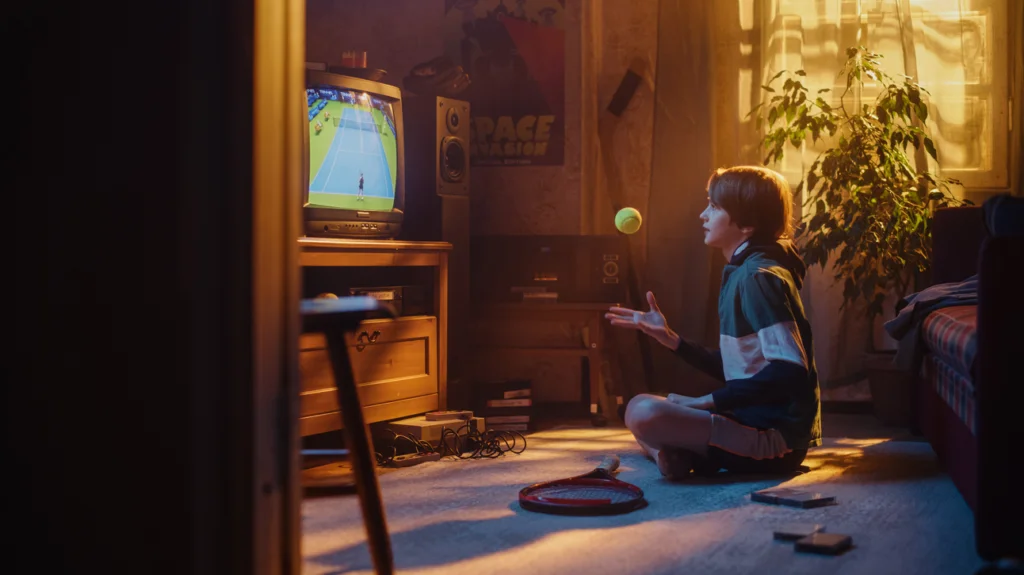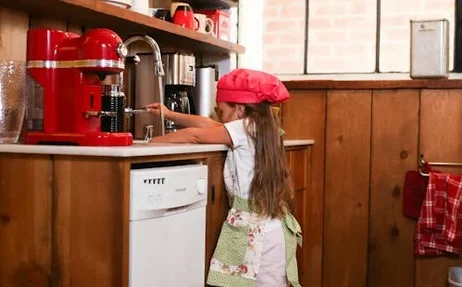The 1970s represented a unique moment in American childhood—after the strict conformity of the 1950s but before the structured activities and technological distractions of later decades. For children growing up during this distinctive era of shag carpeting, wood-paneled station wagons, and Star Wars mania, the after-school hours followed a remarkably consistent rhythm across households nationwide. Whether in suburban developments, rural communities, or urban neighborhoods, kids experienced a blend of freedom and responsibility that shaped a generation’s approach to independence.
1. The Walk Home Without Adult Supervision

In the 1970s, the school day’s end typically meant joining the river of children flowing away from school grounds with not an adult in sight except for crossing guards at major intersections. Kids as young as six or seven routinely walked home alone or with siblings and neighbors, sometimes covering distances that would horrify today’s parents. These walks could stretch up to a mile or more, with children navigating traffic, weather, and occasional neighborhood dogs without cellphones or tracking devices. The New York Times reflects on walking home alone, and the absence of any specific magical age in which this becomes entirely safe.
The journey home often included shortcuts through vacant lots, creek beds, or neighbors’ yards, creating an adventurous transition between the structured school environment and home life. Groups of children would gradually peel away from the pack as they reached their respective streets, casually arranging to meet up later with casual calls of “See you at the park!” or “Come over after dinner!” This daily exercise in navigation and time management built confidence and spatial awareness that many parents now recognize as valuable life skills.
2. The House Key Ritual

For millions of 1970s children, the iconic symbol of after-school life was the house key, often worn around the neck on a shoelace or string. These “latchkey kids” would let themselves into empty homes, as dual-income families became increasingly common and organized after-school programs remained relatively rare. The responsibility of keeping track of this key, unlocking the door, and securing the house afterward represented a rite of passage that signified parental trust. CPI Security explores not just tips to securing your house keys, but also things you definitely should not do.
That first moment of entering an empty house carried its own distinctive feeling—a mixture of independence and slight apprehension that many adults still remember vividly decades later. Children quickly developed routines for this transition: checking for notes on the kitchen counter, calling out “I’m home!” to empty rooms out of habit or just to break the silence, and perhaps turning on the television for background companionship. This daily experience of self-sufficiency helped foster a generation known for its resourcefulness and self-reliance.
3. The Television Power Hour

For most 1970s kids, turning on the television immediately after dropping their school bags was nearly automatic. The after-school television block between 3:00 and 5:00 PM offered a reliable roster of reruns and children’s programming that provided structure to otherwise unsupervised time. Shows like “Gilligan’s Island,” “The Brady Bunch,” “Batman,” and “Star Trek” reruns created shared cultural touchpoints for an entire generation. For the particularly nostalgic, Game Rant has a list of some gems that have been regretably forgotten to time.
The limitations of 1970s television—just three major networks plus PBS and maybe an independent local station or two—meant that children across America were often watching identical programming at identical times. This simultaneous viewing created a shared experience that would be discussed the next day at school, building cultural literacy across geographic and socioeconomic boundaries. The predictability of these television schedules helped children develop time awareness, as they knew precisely how long they had until parents returned home based on which show was currently airing.
4. The Snack Assembly Mission

Creating the perfect after-school snack was a serious undertaking for 1970s children, who typically had free rein of the kitchen during those unsupervised hours. Unlike today’s individually packaged snacks, food often required genuine preparation: making peanut butter and jelly sandwiches, pouring cereal, or constructing elaborate combinations like potato chips with slices of American cheese. Mixing Kool-Aid from powder or making instant pudding represented minor cooking projects that built confidence in the kitchen.
Parents often left specific instructions about snack limitations, but the absence of constant supervision meant these guidelines were frequently subject to creative interpretation. Many children developed impressive negotiation skills with siblings over the fair distribution of coveted items like the last Twinkie or remaining Pringles in the can. This independent food management represented one of the first regular opportunities for children to make their own decisions about appetite and portion control, for better or worse.
5. The Homework Postponement Strategy

Despite parental instructions to “do your homework right away,” most 1970s children developed elaborate systems for postponing this inevitable task until the last possible moment. Homework from the 1970s classroom typically involved workbooks, multiplication tables, spelling lists, or reading assignments from actual textbooks rather than digital platforms. Without parents present to enforce immediate completion, children mastered the art of calculating exactly how long assignments would take and how late they could be started.
The dining room or kitchen table typically served as homework central once children finally surrendered to academic responsibility. Without internet resources, kids relied on encyclopedias, dictionaries, and whatever knowledge they’d actually retained from class. Working through challenging assignments meant struggling through potential solutions rather than finding immediate answers online, building problem-solving persistence that many educators now recognize as valuable. Parents returning home often found children suddenly very busy with schoolwork, creating the impression that this diligence had been ongoing for hours.
6. The Neighborhood Reconnaissance Mission

For many 1970s children, after-school freedom meant immediately setting out to discover who else was available to play, an activity requiring physical legwork rather than text messages. Kids would travel door-to-door throughout the neighborhood, ringing doorbells or developing unique whistles and calls to summon friends. This system created an organic gathering process as groups gradually accumulated children who had completed their own after-school requirements.
The “go find out who can play” mission operated under specific cultural understandings that now seem quaint: you didn’t call friends by phone unless it was raining, you didn’t interrupt dinner at someone’s house, and you always respected the finality of “I can’t come out today.” Children learned to handle small rejections resilience when friends weren’t available and developed negotiation skills when deciding what activity the group would pursue. This daily social organization happened entirely through kid-to-kid communication, with minimal adult moderation.
7. The Outdoor Command Center

Once friend assemblage was complete, 1970s after-school activities typically moved outdoors regardless of weather conditions short of serious storms. Backyards, streets, and local parks became headquarters for elaborate games that relied on minimal equipment but substantial imagination. Kick-the-can, capture the flag, tag variations, and neighborhood-wide hide-and-seek games could occupy hours of time with nothing more than verbal rules established through intense childhood negotiation.
This outdoor time typically operated with remarkable freedom, as children ranged throughout neighborhoods with the simple parental instruction to “be home by dinner.” Without adult oversight, kids settled their own disputes, established and modified rules, and navigated complex social hierarchies through direct experience rather than parental mediation. The outdoor domain existed as a distinct children’s world where kids learned through natural consequences and peer feedback—falling from trees taught physical limitations more effectively than warnings, and unfair play resulted in immediate social consequences from the group.
8. The Sibling Supervision Hierarchy

In multi-child households, older siblings often served as default authority figures during after-school hours, creating a distinct power structure separate from regular family dynamics. Parents explicitly charged older children with responsibilities like “Make sure your brother does his homework” or “Don’t let your sister leave the yard,” establishing a chain of command that many younger siblings alternately resented and relied upon. This arrangement taught older children leadership skills while younger ones learned negotiation tactics.
The sibling supervision system operated with its own complex rules, including what behaviors would be reported to parents versus handled internally through blackmail or bargaining. Many households developed sophisticated economies where younger siblings purchased freedom from oversight through trades, favors, or sworn secrecy about the older child’s own rule-breaking. These negotiations often taught more practical life skills than many formal educational experiences, as children learned to compromise, assess risk, and recognize leverage in relationships.
9. The Chore Completion Countdown

Most 1970s children had assigned household responsibilities that needed completion before parents returned from work. Common tasks included starting dinner preparations (defrosting meat or peeling potatoes), taking meat from the freezer, feeding pets, taking out garbage, or sorting mail. Unlike today’s often-incentivized chore charts with monetary rewards, these duties were simply expected contributions to family functioning, typically without allowance attached.
Children became adept at calculating the minimum time needed to complete these tasks, often waiting until the last possible moment while carefully tracking parental arrival patterns. Many developed impressive efficiency systems, determining exactly how long it took to vacuum the living room or set the dinner table and allowing just enough time before they heard the garage door opening. This time management training, while perhaps not what parents intended, nonetheless built executive functioning skills that proved valuable throughout life.
10. The Dinner Preparation Warning System

As dinner approached, children developed sophisticated methods for detecting imminent parental arrival, which signaled the end of after-school freedom. Neighborhood grapevines spread news of specific parents spotted driving into the area, triggering dispersal of play groups and rapid completion of neglected responsibilities. Children monitored specific sounds with remarkable acuity—the particular rumble of the family car, the garage door mechanism, or footsteps on specific staircases.
The transition from child-governed time to family evening routines often happened with impressive speed, as kids developed multiple contingency plans for parental arrival: abandoned games could be quickly resumed tomorrow, partially completed homework emerged from backpacks, and television channels changed from forbidden programs to approved options. This daily adaptation between different rule sets helped many children develop code-switching abilities and situational awareness that would serve them well in future work environments.
11. The Dinnertime Debrief

Unlike today’s fragmented family schedules, dinner in the 1970s typically brought the entire household together at the same time each evening, creating a natural boundary between after-school freedom and family structure. The family meal served as an information exchange where children faced the ritualistic question, “What did you do today?”—a query that required careful curation of the afternoon’s actual events. Children developed impressive summary skills, highlighting school achievements while strategically omitting unauthorized adventures.
Parents used this time to establish the evening’s schedule and check homework status, often unaware that kids had spent mere minutes on assignments they claimed took “all afternoon.” The dinner table functioned as a daily recommitment to family expectations and values after hours of independent decision-making. This regular recalibration helped children understand boundaries while still experiencing substantial freedom, creating a balanced approach to independence that many psychologists now recognize as developmentally beneficial.
12. The Evening Wind-Down

After dinner, the typical 1970s child’s evening followed a more structured pattern than their after-school freedom. Evening television watching became a family activity rather than solitary entertainment, with programs carefully selected from the limited options on network television. Shows like “Happy Days,” “The Waltons,” or “The Carol Burnett Show” were watched collectively, creating shared references and synchronized emotional experiences across family members.
Bedtime routines typically began immediately after prime-time television concluded, with remarkably early bedtimes by contemporary standards—many elementary-aged children were expected to be in bed by 8:30 PM, with slightly later times for older kids. Without smartphones, tablets, or bedroom televisions, children actually went to sleep shortly after bedtime, ensuring adequate rest for the following day’s identical cycle. This predictable rhythm, while sometimes boring, provided security and structure that child development experts now recognize as critically important for emotional regulation and learning.
The 1970s after-school routine may seem remarkably simple by today’s standards of enrichment activities, digital entertainment, and constant connectivity. Yet this very simplicity fostered independence, creativity, and social development in ways that many parents now consciously try to reintroduce into their children’s overscheduled lives. The freedom to navigate the world without constant supervision, solve problems without immediate assistance, and negotiate social dynamics directly with peers built resilience that became a hallmark of the generation raised with this daily routine. As today’s parents seek balance between safety and independence for their own children, the 1970s after-school experience offers insights into how unstructured time can build capable, confident individuals.


